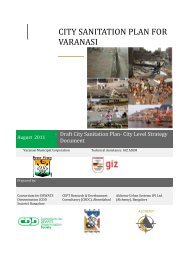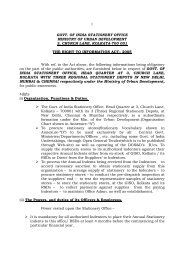CITY SANITATION PLAN - Ministry of Urban Development
CITY SANITATION PLAN - Ministry of Urban Development
CITY SANITATION PLAN - Ministry of Urban Development
You also want an ePaper? Increase the reach of your titles
YUMPU automatically turns print PDFs into web optimized ePapers that Google loves.
<strong>CITY</strong> <strong>SANITATION</strong> <strong>PLAN</strong> BAREILLY<br />
technology if the introduced technology cannot be sustained in the socio-economic, personal or<br />
cultural environment. The users are <strong>of</strong>ten blamed for the failure but the reality is that failure occurs<br />
because the technology is inappropriate to the circumstances.<br />
Regardless <strong>of</strong> the technology selected, making sanitation improvements in any community requires<br />
careful planning and concerted investment efforts between households and government. Lacking<br />
proper coordination, some investments can become very wasteful and redundant. For instance, the<br />
disposal <strong>of</strong> contaminated wastewater in densely populated areas is both expensive and technically<br />
challenging, while the prospects for charging for this service are limited. Thus, if water services are<br />
introduced in an area without a proper drainage and sewerage system, there will be no way to take<br />
away the volumes <strong>of</strong> wastewater.<br />
Sanitation systems can be divided into ‘onsite’ and ‘<strong>of</strong>fsite’ technologies. Onsite sanitation systems<br />
aim to contain human excreta at the point <strong>of</strong> generation (the household level). Onsite sanitation can<br />
be classified into two main categories: ‘wet’ which require water for flushing; and ‘dry’ which do not<br />
require any water for flushing. This type <strong>of</strong> infrastructure comprises <strong>of</strong> (improved) latrines, septic<br />
tanks and other household level technologies that do not involve sewerage.<br />
Offsite sanitation systems transport human excreta to another location for treatment, disposal or<br />
use. Offsite sanitation can be classified into two main categories: ‘decentralized’ and ‘centralized’.<br />
Decentralized systems include systems where groups <strong>of</strong> two or more houses are linked to a network<br />
leading to a communal treatment system. Wastewater systems serving one or several communities<br />
are termed centralized systems.<br />
Technology Option for On-site sanitation systems<br />
Septic Tank with soak pits<br />
Application Level- Household, Apartments, Institutions<br />
Septic tanks consist <strong>of</strong> a chamber or series <strong>of</strong> chambers into which wastewater is discharged and<br />
contained. Sediment and solids settle at the bottom <strong>of</strong> the tank and organic wastes are decomposed<br />
by the action <strong>of</strong> bacteria. The effluent from septic tanks may contain pathogens and should be<br />
discharged into a soak away. In practice, many septic tanks in India discharge effluent to the nearest<br />
open drain.<br />
ADMINISTRATIVE STAFF COLLEGE OF INDIA, HYDERABAD Page 147
















